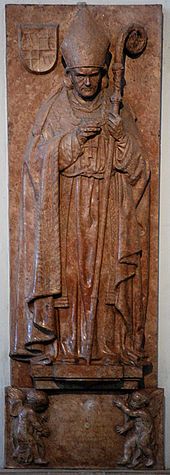Ferdinand Schlör
Ferdinand Adam Nikolaus Schlör (born March 2, 1839 in Richelbach , today Neunkirchen , † June 2, 1924 in Würzburg ) was a German theologian, priest and, as Ferdinand von Schlör, Bishop of Würzburg from 1898 to (1920) 1924.
Life
Ferdinand Schlör studied theology in Würzburg and was ordained a priest there on August 16, 1862. After pastoral activities in various places, he returned to Würzburg in 1880, where he took over the management of the newly established Julianum and was mainly active in pastoral care and educational work for young people. He was appointed cathedral capitular in 1891 and on March 5, 1898 by Prince Regent Luitpold Bishop of Würzburg. He was ordained bishop on March 24, 1898, by the Archbishop of Bamberg, Joseph von Schork ; Co- consecrators were Franz Leopold von Leonrod , Bishop of Eichstätt, and Joseph Georg von Ehrler , Bishop of Speyer.
Starting from the Catholic enclave Wolfmannshausen , which was looked after by the diocese of Würzburg and was the only supervised parish to belong to Saxony-Meiningen , the Catholic community had expanded further in neighboring Meiningen and Hildburghausen . Ferdinand von Schlör and the priest Kilian Josef Meisenzahl who supported him maintained good relations with the dukes Georg II and later Bernhard III. Other neighboring dioceses also carried out development work, for example the Archdiocese of Bamberg in Sonneberg or the Diocese of Paderborn for Pößneck or Saalfeld. On July 9, 1917, the ducal state ministry agreed that the existing curates would be elevated to parishes and that an episcopal commissariat be set up in Meiningen . The whole development went hand in hand with the establishment of new churches.
He supported in his time uncomfortable Herman Schell , who is also in dispute with Pope Pius X fell.
Schlör was an honorary member of the Catholic student union KDStV Cheruscia Würzburg in the CV .
On June 7, 1920, the Archbishop of Bamberg, Johann Jakob von Hauck, was appointed Apostolic Administrator of the Diocese of Würzburg, as Schlör was no longer able to lead the diocese properly at the age of 81 due to increasing old age. Bishop Schlör, popular with the population and advocating a Christian-Israelite understanding, died in 1924.
The Ferdinandeum
On the initiative of Ferdinand von Schlör, the Ferdinandeum study seminar was established in Würzburg in 1908 , which was also available to students as a Catholic dormitory. Until 1936, the church services of the community of Our Lady (Würzburg) took place in the chapel there . The theology student and later Bishop Josef Stangl as well as the religious education student Anneliese Michel lived in the Ferdinandeum . The Ferdinandeum was reopened in the winter semester of 1956/60 (after the destruction caused by the Second World War) as a dormitory for 125 students from the Pedagogical University under Bishop Stangl, who took over the protectorate of the association “ Wohnheim für Lehrerstudenten eV” founded for this purpose, and is still today a dormitory on Schlörstrasse named after Ferdinand Schlör.
literature
- Alfred Wendehorst: The Diocese of Würzburg 1803–1957 ; Würzburg 1965; Pp. 73-80.
- Klaus Wittstadt : Church and State in the 20th Century. In: Ulrich Wagner (Hrsg.): History of the city of Würzburg. 4 volumes, Volume I – III / 2, Theiss, Stuttgart 2001–2007; III / 1–2: From the transition to Bavaria to the 21st century. 2007, ISBN 978-3-8062-1478-9 , pp. 453–478 and 1304 f., Here: pp. 455–458: The Church Development under Bishop Ferdinand Schlör (1898–1924).
Web links
- Literature by and about Ferdinand Schlör in the catalog of the German National Library
- Entry on Ferdinand Schlör on catholic-hierarchy.org
- List of bishops of the Diocese of Würzburg
- Edwin Neckermann: Family tree Neckermann Vilchband: von Schlör, Ferdinand Adam Nikolaus .
Individual evidence
- ↑ From the poor house to the bishop's chair . In: Main-Echo. (March 1, 2014).
- ↑ Klaus Witt City: church and state in the 20th century. 2007, p. 455.
- ↑ Klaus Wittstadt Würzburger Bishops 742–1979 Echter Verlag 1979, p. 85.
- ↑ Klaus Witt City: church and state in the 20th century. 2007, p. 455.
- ^ Sybille Grübel: Timeline of the history of the city from 1814-2006. In: Ulrich Wagner (Hrsg.): History of the city of Würzburg. 4 volumes, Volume I-III / 2, Theiss, Stuttgart 2001-2007; III / 1–2: From the transition to Bavaria to the 21st century. Volume 2, 2007, ISBN 978-3-8062-1478-9 , pp. 1225-1247; here: p. 1235.
- ↑ Klaus Witt City: church and state in the 20th century. In: Ulrich Wagner (Hrsg.): History of the city of Würzburg. 4 volumes, Volume I-III / 2, Theiss, Stuttgart 2001-2007; III / 1–2: From the transition to Bavaria to the 21st century. 2007, ISBN 978-3-8062-1478-9 , pp. 453–478 and 1304 f., Here: pp. 470–475 ( renewal in the spirit of the Second Vatican Council - Bishop Josef Stangl (1957–1978) ). P. 471
- ↑ Student Bureau : Ferdinandeum .
| personal data | |
|---|---|
| SURNAME | Schlör, Ferdinand |
| ALTERNATIVE NAMES | Schlör, Ferdinand Adam Nikolaus (birth name); Schlör, Ferdinand von |
| BRIEF DESCRIPTION | Theologian and Bishop of Würzburg |
| DATE OF BIRTH | March 2, 1839 |
| PLACE OF BIRTH | Richelbach, today Neunkirchen (Lower Franconia) |
| DATE OF DEATH | June 2, 1924 |
| Place of death | Wurzburg |




